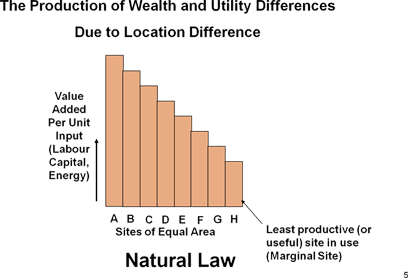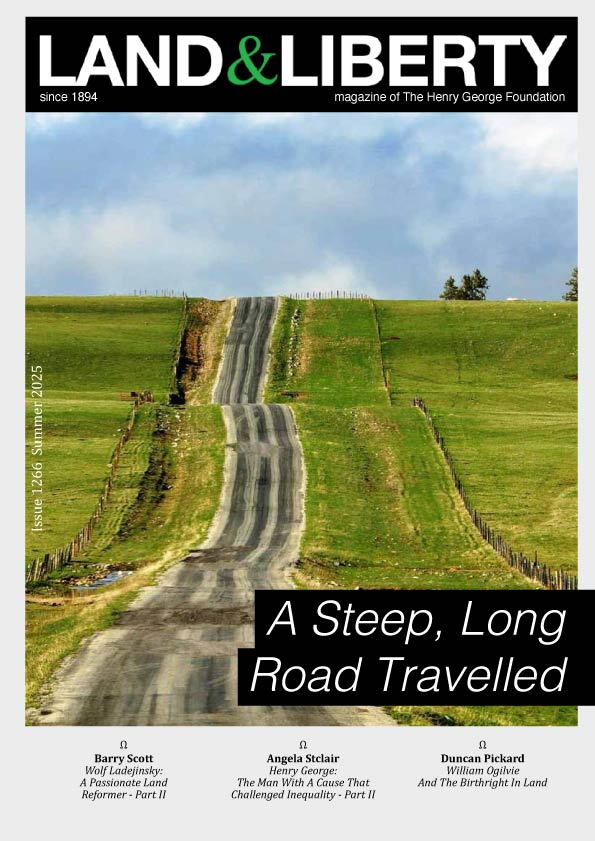Get Updates
Progress without Poverty
Page 3 of 7
Simple ‘Economic Community’
 Each column in Figure 3 represents the value added by a firm within a small economic community where each firm occupies a unique location, and each location, whilst of equal size varies in respect of its economic response to the input of human enterprise, capital and energy etc. In the interests of simplicity the economic community indicated here consists of only eight firms. The height of each column represents the value added on that site for a unit of input. Thus whilst inputs are equal, the differences in output, (value added), are due entirely to the inevitable peculiarities of each particular location. This phenomenon is a feature of every economic community – every village, town, city, country and continent – world wide. Its presence may be obscured by the very real differences in inputs that occur in the real world but the differences in output that arise as a result of differing inputs of enterprise, skill, capital etc., overlay the differences indicated here, they do not nullify them.
Each column in Figure 3 represents the value added by a firm within a small economic community where each firm occupies a unique location, and each location, whilst of equal size varies in respect of its economic response to the input of human enterprise, capital and energy etc. In the interests of simplicity the economic community indicated here consists of only eight firms. The height of each column represents the value added on that site for a unit of input. Thus whilst inputs are equal, the differences in output, (value added), are due entirely to the inevitable peculiarities of each particular location. This phenomenon is a feature of every economic community – every village, town, city, country and continent – world wide. Its presence may be obscured by the very real differences in inputs that occur in the real world but the differences in output that arise as a result of differing inputs of enterprise, skill, capital etc., overlay the differences indicated here, they do not nullify them.
The importance of viewing an economy in this way i.e. setting the firm’s inputs as equal on all sites, is that it enables us to identify that part of the output that is due to the firm’s inputs only, and that part of the firm’s output that is due to advantages of their location, compared with others in the same community. In a money based trading economy the relevant output, since it is sold, is in fact it’s net ‘income’ and the income that is due to a firm on account of its inputs may be regarded as it’s ‘Earnings’. It represents the sum of the returns due to its component inputs viz. Labour (wages) Capital (interest) and Enterprise (profit), It is clear that firm ‘H’ occupies a site that enjoys no overall economic advantage when compared with any of the other sites within this community. The full value added by the firm’s inputs on this site is thus all ‘earned’ i.e. its ‘Earnings’. Since all firms are assumed to provide equal inputs they all ‘earn’ a similar amount i.e. equal to that earned on the least productive site in use (the margin) – site ‘H’.
The additional value shown on the seven sites A – G in excess of the general level of earnings (established at the margin ‘H’) is due entirely to the enhanced economic qualities that those sites enjoy. The occupants do not create that additional value by virtue of their own efforts or enterprise etc. but because the community permits and protects their exclusive occupancy of sites that happen to be superior to the least productive site in use (marginal site H).
We may thus see that this extra value added is by virtue of the services, infrastructure and protections that the community as a whole provides to each and every site occupant. As we noted earlier the extent of this benefit varies from site to site.
Ricardo’s Law of Rent
It will be apparent to many that we have here employed a model based upon one of the most basic and universally recognised theories of classical economics namely ‘Ricardo’s Law of Rent’ where this surplus is termed ‘The Economic Rent of Land’. It may be noted that in his original model Ricardo assumed that variations in productivity were due to varying fertility such that the crop yield reflected such variation. Here we make no such assumption but we do assume that each firm employs an equivalent amount and quality of human enterprise, capital equipment and energy on their location.
Figure 4
Figure 4 thus shows how the two Primary Factors of Production (labour and land) give rise to a Primary Division of Wealth consisting of two parts (earnings and rent). It should also be noted that this ‘primary division’ is not based upon any claims being exercised by any of the players in the economic process of production. It does not arise due to the relative strengths or weaknesses of anybody’s bargaining or market position but rather from the nature of economic activity itself, taking place within the context of civil society. We may thus contrast this ‘primary division’ (arising from economic ‘factors’) with the primary and secondary ‘distributions’ of wealth that take place in the economy today which are very much dependent upon the relative strengths of competing claims and claimants.
Donate Today
Bank Transfer
DonateHelp us minimise transaction fees and administrative costs by donating via bank transfer.
PayPal
To Gift Aid your donation, please request a Gift Aid Declaration Form >

